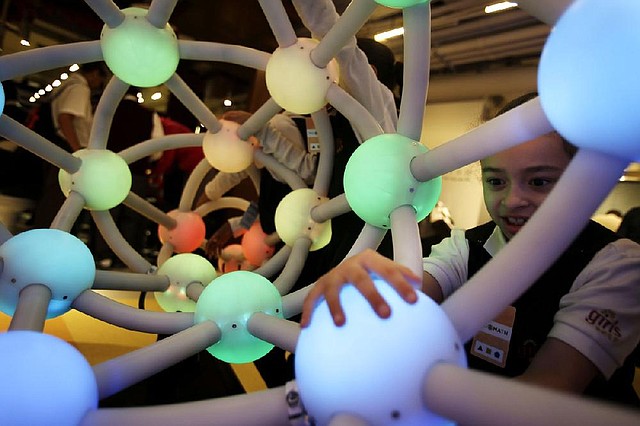Math museum adds up to lots of fun
Girls Preparatory student Faith Guzman tries out an interactive display at the National Museum of Mathematics in New York.
Sunday, March 24, 2013
NEW YORK - Squealing schoolchildren ride a square wheeled tricycle and a “Coaster Roller” that glides over plastic acorns. Downstairs, they fit monkey magnets together at the “Tessellation Station.”
This is how math is presented at New York’s brand-new National Museum of Mathematics, the only museum of its kind in the United States and a place where math is anything but boring.
“Math’s not just memorizing your multiplication tables,” said Cindy Lawrence, the museum’s associate director. “Math is a creative endeavor, and that’s what we want people to realize.”
The museum, nicknamed Mo-Math, is on two floors of an office building north of Manhattan’s Madison Square Park. It is the brainchild of executive director Glen Whitney, 42, a mathematician and former hedge fund analyst who helped raise $23.5 million for the 19,000-square-foot museum.
Whitney said prominent mathematicians gladly shared their expertise for the museum’s hands-on exhibits.
“They’re absolutely thrilled,” he said. “They’re so giving of their time and their energy and their enthusiasm. And I think a lot of mathematicians sort of get the sense that they are working in a misunderstood field.”
The museum’s target audience is fourth through eighth grades but the exhibits can be enjoyed by younger children on one level while challenging adults on another.
The point of the Coaster Roller is that the acornlike shapes have a constant diameter although they are not spheres, so the clear plastic sled glides smoothly over them.
The square-wheeled trike works because the wheels align with the exhibit’s bumpy track. The bumps are not just any bumps; each one is an upside-down catenary, the shape formed by a chain when you hold both ends.
Other exhibits allow museum goers to create objects that will be put on display, either by building them with a Tinker Toy-like system called Zome Tools or by computer modeling.
Whitney said one structure built by visitors during MoMath’s first weekend was a truncated dodecahedron, which is a three-dimensional shadow of a four-dimensional shape.
The Tessellation Station is a wall that visitors can cover with like-shaped magnets.
Tessellation is the process of creating a plane using repeated geometric shapes, such as a floor tiled with squares or hexagons. MoMath visitors can build tessellations with pieces shaped like rabbits, monkeys and dinosaurs. There also is a Marjorie Rice pentagon, named for an amateur mathematician whose tessellation discoveries were later confirmed by professionals. The museum is highlighting Rice’s work in part to spark girls’ love of math.
Sharon Collins, a high school math teacher at Bronx Preparatory Charter School who brought a group, said her students enjoyed the square wheeled tricycle just as much as the younger kids did.
“The students would ride the bike and then think, why am I able to ride the bike,”Collins said. “They saw the real-world connections of math, which are sometimes missing in a classroom setting.”
Second-grader Desiree Thomas of Girls Prep on the Lower East Side was there with her class as well.
“I think that it’s very interesting, and I think that it’s fun,” Desiree said. “I’m building with different shapes, and I’m playing on them.”
Jennifer Florez brought her 4-year-old son to Mo-Math. She said they’ll return for more visits.
“He’s a little young for some of the exhibits but there’s enough here to keep little ones engaged,” she said. “This will be a museum we’ll come back to and revisit as he gets older.”
MUSEUM OF MATH: 11 E. 26th St., Manhattan; momath.org or (212) 542-0566. Open daily 10 a.m.-5 p.m.
Travel, Pages 48 on 03/24/2013
